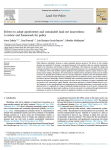Zabala A., Pascual U., García-Barrios L.E., Mukherjee N. (2025). Drivers to adopt agroforestry and sustainable land-use innovations: a review and framework for policy. Land Use Policy, 01/04/2025, vol. 151, p. 107468.
https://doi.org/10.1016/j.landusepol.2025.107468
https://doi.org/10.1016/j.landusepol.2025.107468
| Titre : | Drivers to adopt agroforestry and sustainable land-use innovations: a review and framework for policy (2025) |
| Auteurs : | A. Zabala ; U. Pascual ; L.E. García-Barrios ; N. Mukherjee |
| Type de document : | Article |
| Dans : | Land Use Policy (vol. 151, April 2025) |
| Article en page(s) : | p. 107468 |
| Langues : | Anglais |
| Langues du résumé : | Anglais |
| Catégories : |
Catégories principales 06 - AGRICULTURE. FORÊTS. PÊCHES ; 6.4 - Production Agricole. Système de ProductionThésaurus IAMM SYSTEME DE PRODUCTION ; AGROFORESTERIE ; INNOVATION ; UTILISATION DES TERRES ; DURABILITE |
| Résumé : | What influences individuals' decisions to adopt sustainable land-use practices? The drivers of such complex decisions are manyfold. We develop a conceptual framework of the predictors that are external (contextual), related to the innovation, and internal or intrinsic to individuals. This framework can guide the design and evaluation of policies to encourage such decisions and subsequent behaviour. The conceptual framework is based on a literature review that includes empirical qualitative and quantitative analyses, mainly focused on agroforestry and its subtype, silvopasture. We inventoried 207 adoption drivers (predictors) used across the studies reviewed. We grouped these predictors into key concepts along these categories: farm and household characteristics, social environment and institutions, individual objective and subjective factors, and variables related to the land-use practice (knowledge, technical feasibility and economically rational motives). The concepts in the framework incorporate and enhance those proposed in earlier reviews of adoption of a range of sustainable land-use practices (soil conservation, organic farming, conservation agriculture, ecological farming practices, etc.). The framework is also interdisciplinary and comprehensive by including behavioural, socioeconomic and biophysical factors. It is applicable to a range of sustainable farming innovations. It can be used to evaluate policy ex-ante, by assessing what place-based conditions or barriers may need to be addressed through tailored policy instruments, as well as to inform the selection of explanatory variables in ex-post evaluations. |
| Cote : | En ligne |
| URL / DOI : | https://doi.org/10.1016/j.landusepol.2025.107468 |







